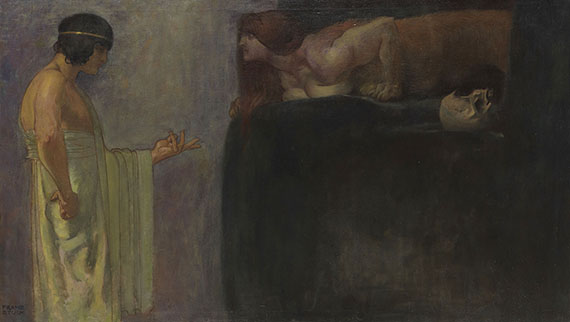Dictionary


Deutschrömer
Two artist groups can be referred to as "Deutschrömer". On the one hand the Nazarenes, who traveled to Rome at the beginning of the 18th century, with the intention to work more freely as they were unsatisfied with the study conditions at the Vienna Academy. Another group of artists was actually called "Deutschrömer", they were representatives of Neoclassicism, and went to Rome as of the 1850s. The three main protagonists were Anselm Feuerbach (1829-80), Hans von Marées (1837-87) and Arnold Böcklin (1827-1901). A feature that these artists have in common is the rejection of a realistic style of painting, deliberately turning to a form of art that is inspired by their own imagination on the one hand and by a classical and ancient vocabulary on the other. Seeking direct contact with the ancient spirit, the artists traveled to Italy, in order to study the ancient models. Their favorite subjects were landscapes, historical scenes and portraits. An easy stroke of brush that emphasizes the pictorial element can be observed. The landscapes allow a view into the distance, the clouds dramatizing the scene. The fantastic element becomes most obvious in works by Böcklin, who depicts symbolically charged women, nymphs and natural beings.
Other members of the "Deutschrömer" were Oswald Achenbach, Reinhold Begas, Karl Heinrich Dreber, Heinrich Louis Theodor Gurlitt, Adolf von Hildebrand, Friedrich Preller the Elder and Hans Thoma.
Two artist groups can be referred to as "Deutschrömer". On the one hand the Nazarenes, who traveled to Rome at the beginning of the 18th century, with the intention to work more freely as they were unsatisfied with the study conditions at the Vienna Academy. Another group of artists was actually called "Deutschrömer", they were representatives of Neoclassicism, and went to Rome as of the 1850s. The three main protagonists were Anselm Feuerbach (1829-80), Hans von Marées (1837-87) and Arnold Böcklin (1827-1901). A feature that these artists have in common is the rejection of a realistic style of painting, deliberately turning to a form of art that is inspired by their own imagination on the one hand and by a classical and ancient vocabulary on the other. Seeking direct contact with the ancient spirit, the artists traveled to Italy, in order to study the ancient models. Their favorite subjects were landscapes, historical scenes and portraits. An easy stroke of brush that emphasizes the pictorial element can be observed. The landscapes allow a view into the distance, the clouds dramatizing the scene. The fantastic element becomes most obvious in works by Böcklin, who depicts symbolically charged women, nymphs and natural beings.
Other members of the "Deutschrömer" were Oswald Achenbach, Reinhold Begas, Karl Heinrich Dreber, Heinrich Louis Theodor Gurlitt, Adolf von Hildebrand, Friedrich Preller the Elder and Hans Thoma.
Offers




